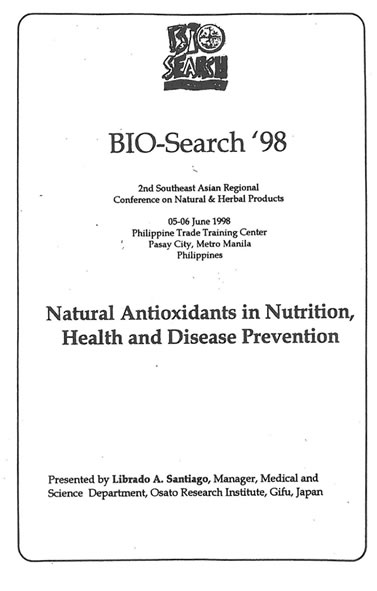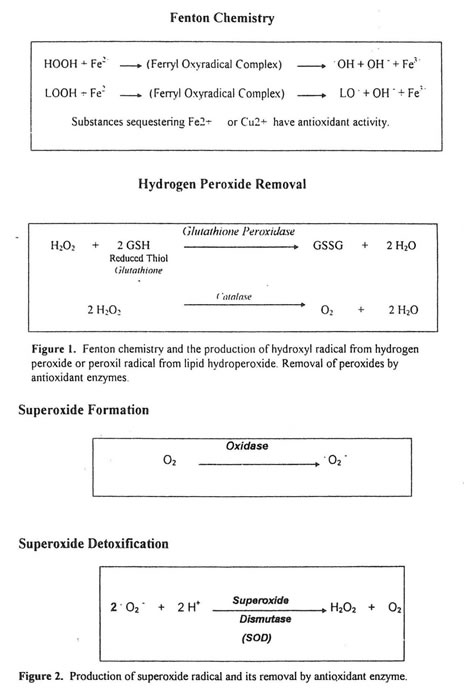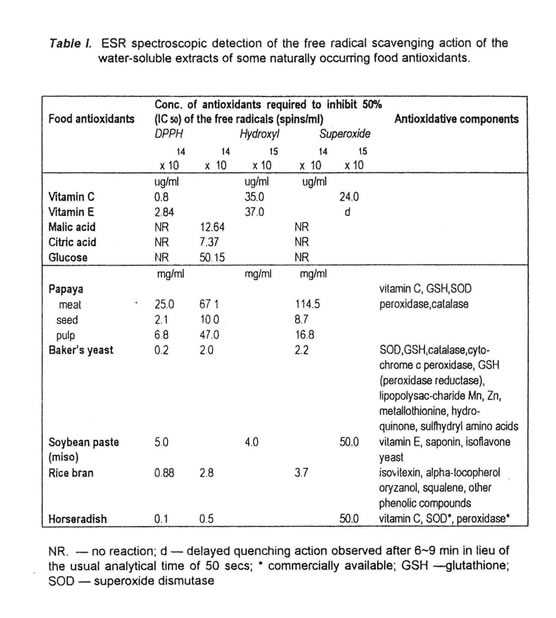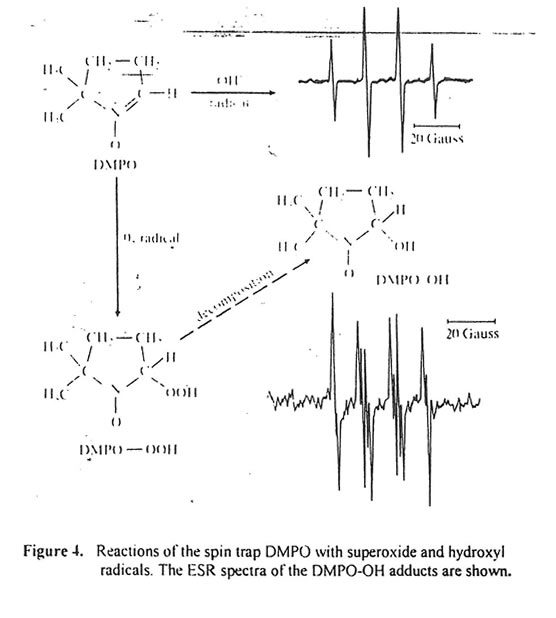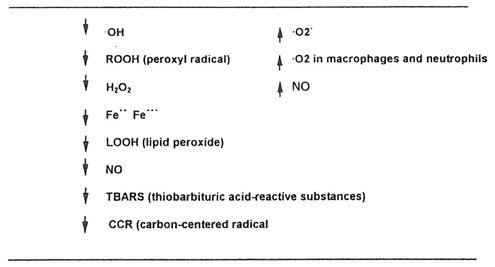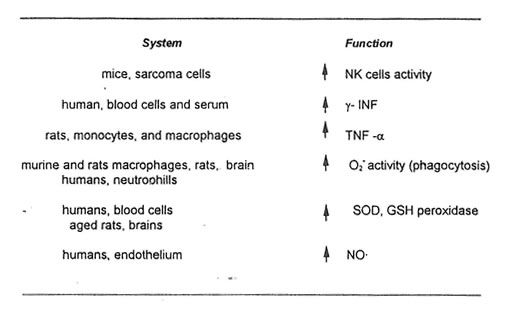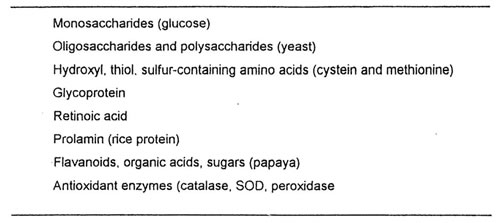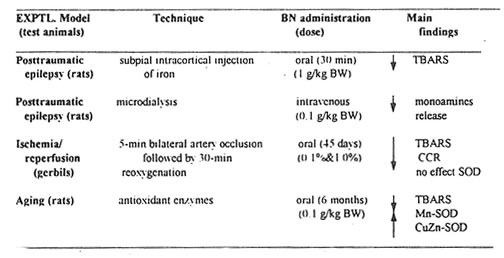| Title | NATURAL ANTIOXIDANTS IN NUTRITION, HEALTH AND DISEASE PREVENTION |
|---|---|
| Year | 1998 |
| Author | Librado A. Santiago, Ph.D. |
| Publisher | 2nd Southeast Asian Regional Conference on Natural and Herbal Products; 5-6 June, 1998 |
NATURAL ANTIOXIDANTS IN NUTRITION, HEALTH AND DISEASE PREVENTION
by
Librado A. Santiago, Ph.D.
Overview
The theory on oxygen toxicity has revolutionized the present knowledge on the genesis of disease and its prevention. Though oxygen is biologically friendly, scientists have linked destructive oxygen reactions, the most dangerous and best-studied are so called oxygen free radicals, to at least 60 different chronic diseases, including ‘ aging. Renegade oxygen molecules called oxidants are waste products of ordinary metabolic processes or they may come from the environment. They attack biomolecules like DNA, proteins, and fats. . Hence, a better antioxidant defense against the overproduction. of reactive free radicals as provided for in the diet is necessary.
Nothing protects health and extends life more than steady supply of potent antioxidants to the body cells. Herbal Plants, food supplements, and antioxidant preparations abound in our country, but studies, on their antioxidant activity are sorely lacking. To date, astonishing new scientific findings on the healing and preventive power of disease-fighting antioxidants have been unveiled in other countries.
Our work for eight years has focused on testing in vitro the free radical scavenging activity of some of these food antioxidants including a new commercially available fermented product from Philippine papaya, called Bio-normalizer using electrospinresonace chemiluminescence technique in vivo………………………………………….
………………………….models and in-well-controlled double blind studies ………………………….
Bio-normalizer a registered food supplement ……………… sweet white granular preparation It induces the natural adaptive systems such as free radical regulatory immunomodulator, heavy metal chelation and antioxidant defenses of the body. It improves the quality of life by alleviating the pain and discomfort caused by disease. It has demonstrated interesting and even astounding effects on cancer-afflicted person’s diabetes, heart disease, brain dysfunction, aging and even in AIDS. Although it does not claim to provide complete remedy or cure the patients conditions are improved and their lifespans are prolonged. Isolation purification and characterization of some of its important bioactive components is in progress.
Introduction
A trend for all things natural is now seen in the inclination of the public to turn back to the basics by the growing application of herbal plants, thus generating much of the research interests on the antioxidant and immunomodulatory properties of such products as their benefits in nutrition, health and disease prevention are limitless. None of the hundreds of antioxidant preparations available in the local market has scientific basis for such claim. Three major objectives of this paper are to present the techniques in measuring the free radicals, demonstrate the antioxidant activities in vitro and in vivo of one commercial product. Bio-normalizer and prove its clinical efficacy in several clinical trials.
Oxygen toxicity and free radicals
The new theory of oxygen toxicity has revolutionized current medical practice. Over 60 different chronic diseases, as well as aging, have implicated harmful oxygen free radicals. These renegade oxygen molecules called oxidants have one or more unpaired electrons which render them unstable, reactive and dangerous. Oxidants are waste products of ordinary metabolic processes, such as breathing. Some are beneficial but many are destructive, especially those that come from the environment such as cigarette smoke, ultraviolet and ionizing radiation, air pollutants, toxic industrial chemicals, pesticides and drugs. They come in various forms and guises and are apt to destroy biomolecules such as DNA, proteins and fatty acids among others (1). Oversupply of oxidants is bad for health; therefore, the body needs a check-and-balance of oxidants and antioxidants. Two of the most-studied oxygen radicals are hydroxyl (˙OH) and superoxide (˙O2–). The ˙OH is formed by the hydrolysis of water caused by ionizing radiation or by the reaction of hydrogen peroxide (H2O2) with heavy metals such as iron as in Fenton reaction shown, in Figure 1. H2O2 removal is facilitated by glutathione (GSH) peroxidase (1) and catalase. The ˙O2– is generated during energy metabolism either thru self-oxidation or enzymatic reaction with oxidases. Superoxide dismutase (SOD) quenches ˙O2– as depicted in Figure 2.
Natural antioxidants
Antioxidants are chemical weapons of the body that directly oppose oxygen charged molecules, thought to ward off chronic diseases, including, heart disease, brain dysfunctions (stroke, trauma, epilepsy, Parkinson’s), hypertension diabetes, asthma, bronchitis, cataract, kidney problem and aging. The body is endowed with endogenous antioxidants found in various biological compartments (2) as shown in Figure 3. Whereas, exogenous antioxidants supplied to the body are heavily concentrated in foods. Sesame seed, onion and garlic are exceptionally strong antioxidants. Major antioxidant compounds in foods are b -carotene found in dark orange and dark green leafy vegetables; GSH in avocado, asparagus and watermelon; indoles in broccoli, cabbage, cauliflower, horseradish, mustard and radish; lycopene in tomatoes; quercetin in yellow and red onions, red grapes and broccoli; ubiquinol-10 or coenzyme Q10 in soybeans, walnuts and sesame seeds; vitamin C in red and green bell peppers, brocolli, cauliflower, strawberries, spinach, citrus fruits and cabbage; and vitamin E in vegetable oils, almonds, soybeans and sunflower (3). This explains in part why vegetarians outlive meat-loving people.
Figure 3. Major natural antioxidants found in various biological compartments.
(Packer, L., 1995; Oxidative Stress, Antioxidants, Aging and Disease)
Thru electron spin resonance (ESR) spectrometry studies, we have unequivocably demonstrated the free radical scavenging action of some naturally occurring food antioxidants in comparison to standard antioxidants or scavengers as shown in Table 1. Papaya, baker’s yeast, miso and wasabi are potent scavengers of oxygen radicals and 1, 1-diphenyl-2-pcrylhydrazyl (DPPH) radical. Among the different parts of papaya, the seed has the highest potency. Baker’s yeast and horseradish are excellent DPPH and OH quenchers. Rice bran and baker’s yeast are good scavengers of ’02.The antioxidative components of each naturally occurring antioxidants are enumerated. The details are discussed elsewhere. (4-9)
Detection of hydroxyl and superoxide radicals
Two of the least ambiguous and popular equipment used to detect and measure oxygen radicals are ESR coupled with spin trapping (11), and chemiluminescence. ESR can detect the presence of unpaired electrons. Highly reactive radical, difficult to observe by normal ESR, are allowed to react with a spin trap, for example, 5,5-dimethylpyrroline-N-oxide (DMPO) to produce a long-lived radical and capable of producing highly characteristic ESR spectrum (1) as shown in Figure 4.
Phagocytes produce light emission which is greatly enhanced in the presence of luminal or lucigenin. This background light emission is due to the production of “02” and H2O2, by the phagocytes, leading to the chemiluminescence that accompanies oxidant production (1).
The immune system
The immune system of the human body is a dynamic defense network of an army of cells and molecules that work in concert in maintaining equilibrium when infection ensues. The skin, glands. Mucous membranes and ciliary apparatus are examples of natural or non-specific immunity of the body. The other type is called specific or adaptive immunity comprising antibodies and cells which attack and destroy specific intruders. Examples are the B-cell and T-cell lymphocytes. The former produce critical antibodies that rush to destroy foreign matter. Such as viruses, bacteria and tumor cells. The latter direct many immune activities and produce two substances called interferon (IFN) and interleukin that are essential in warding off infections and cancer. The IFN are glycoproteins released by virus-infected cells. IFNs do not kill virus 01′] their own but they send signal to the components of immune system to proliferate In case of infection The three ‘Nell-studied types of interferons are the alpha (α)-. beta (β)-. and gamma (γ) -IFNs. α-IFN are those produced by white blood cells. β-IFN from fibrous connective tissue, and γ-INF from activated T-lymphocytes. Alpha- and β-IFN can inhibit viral replication while γ-IFN may activate macrophages, natural killer cells, and other cells. The interleukins consist of several subsets which are produced by macrophages, T-lymphocytes, and other cells. They activate various cells of the immune system to grow, differentiate, or synthesize specific products. Natural killer (NK) cells are the body’s first line of defense against the development of cancer; they destroy cancer cells as well as virus-infected cells.
Product Information
Bio-normalizer a product of Osato Bio-Industry Corp., Japan, is a functional food made from fermenting a Philippine variety of papaya, other traditional Japanese herbs and grains. It is a sweet, white, granular fermented product registered with BFAD and with the State Committee of the Russian Federation on Sanitary and Epidemiological Control in Russia as a food supplement. It has complied with the Food Act of 1983 and Food Regulation of 1985 of Malaysia. It is presently marketed in Japan, Philippines, USA, Russia, Malaysia, Korea, France, Italy and the Netherlands.
Bio-normalizer product of Osato Bio-Industry Corp., Japan, has undergone several pharmacological tests to confirm and validate its safety for human consumption such as lethal dose (LD5o) determination, acute toxicity test, heavy metal and harmful compounds analysis, regulated drug assay, effect on liver metabolism, among others. A basic dose of three grams of Bio-normalizer daily is recommended.
Scientific evidence
Three mechanisms of actions of Bio-normalizer interwoven and correlated, namely as a free radical regulator, immunomodulator and heavy metal chelator, have been scientifically documented and published in more than 30 credible international scientific journals. Bio-normalizer is not a drug; nonetheless, it manifests therapeutic ability in some if not all types of diseases. It offers better quality of life (QOL) to people suffering from illness,
1. Free radical regulator
Bio-normalizer was unequivocaly demonstrated by ESR to be potent scavenger of ·OH (with an IC50 of 5 mg/ml) but not ·O2– (12). Similar result was obtained using chemiluminescence technique. Bio-normalizer quenched peroxyl radicals (13) and lipid peroxides in brain tissues induced by iron (14). Further, Bio-normalizer was found to stimulate the production of ·O2– by phagocytic cells such as neutrophil and macrophages (14). Neutrophils are infantry of the host defense system which eliminate invading microorganisms by producing powerful oxidizing agents such as ·O2– Bio-normalizer was found to increase the GSH levels In blood monocytes (13) and SOD activity In brain tissues of aged rats (14) A decrease In ·O2–production was observed In leukocytes of diabetic patients which otherwise was restored to normal values by Bio- normalizer administration (unpublished data)
Bio-normalizer showed dual action on nitric oxide (NO) a gaseous free radical synthesized in mammals by NO’ synthase isoenzyme. While Bio-normalizer inhibited NO production in a dose-dependent manner in murines peritoneal neutrophils and macrophage. It enhanced the NO production induced by low dosages of γ-INF (unpublished data) The results are summarized in Table 2 Other researchers have shown that NO causes relaxation of blood vessels and the central and peripheral nervous systems, and is also a cytostatic cytolytic effector molecule of host immune defenses against bacteria. Parasites and tumors it regulates blood flow and blood pressure and inhibits platelet organization. If NO production is impaired circulatory and respiratory disorders, diabetes and cancer develops for instance. Diabetics have low level of blood NO (17) and are prone to many complications such as high blood pressure.
This property of Bio-normalizer suggests a link between the free radical antioxidant status in regulating the redox state of the organism and preventing onset of disease.
2. Immunomodulator
Impaired immune function and autoimmune dysfunction may be remedied by antioxidant supplementation. The body can fight foreign invaders that enter the body and repair damaged tissues thru its antioxidant defense system, immune cells including antibodies and redox regulation. However, some of these protective mechanisms are being depleted, get worn-out, malfunction, and the cells get infected or die Therefore the body needs something to boost or prime the immune system Bio-normalizer is performing most of these By stimulating a) tumor-necrosis factor (TNF·α) I which is a known potent mediator of cytotoxicity of macrophages and monocytes in the blood b) γ-INF level in the body which can control viral infection(16) c) NK cells which has the ability to destroy tumor cells and possibly control viral infections in human (17) d) body antioxidant defenses such as SOD. GSH peroxidase (18 19) among others Moreover. Bio-normalizer augmented the enzymic production of inducible NO· synthase and stimulated the cytokine-activated (TNF-α) transcriptional regulation of production (unpublished data) (Table 3).
Table 2. Free radical regulating properties of Bio-Normalizer
Table 3. Immunomodulating properties of Bio-Normalizer
These regulatory effects on the cellular redox status and immuno- correction ability could have clinical relevance to the destruction of infectious bacteria or virus during host defense.
1. Heavy metal chelator
As an antioxidant, Bio-normalizer sequesters iron or perhaps even copper in Fenton chemistry (see Figure 2). Sequestration of copper or iron will diminish radical generation promoted by these metals. Table 4 summarizes the results on the metal chelating properties of Bio-normalizer. Using tumor cell cultures treated with platinum-based chemotherapeutic agents, Bio-normalizer reduces the toxicity of this metal (unpublished data). Using cell culture of rat macrophages, Bio-normalizer counteracts the cytotoxic effects of cobalt ions and asbestos fibers. Bio-normalizer reverses the toxic effects of iron overloading and anti- cancer drug Bleomycin, and suppresses lung inflammation and fibrosis in guinea pigs and rabbits intracheally injected with soluble heavy metal ion solution (Table 4). It is likely that Bio-normalizer induces metallothionine within the cells. The –SH groups in metallothionine makes them excellent scavengers of singlet oxygen and OH and they can bind ions of such metals as zinc copper cadmium and mercury Bio -normalizer contains potential chelating agents such as oligo- and polysaccharides, amino acids like cysteine and methionine. oligo- and polypeptides and flavonoids (Table 5).
In a double-blind, randomized. case-controlled study conducted at the Institute of Occupational Health in Kiev, Ukraine, employing 45 laborers suffering from chronic lead toxicity and with lead exposure of not less than10 years while working at radio, mining, smelting and printing industries, and people directly involved in the clean-up of the Chernobyl nuclear explosion. it was shown that after 4 weeks of Bio-normalizer administration at different dosages of 3, 6 and 9 grams, the lead content in the blood increased dose-dependently, suggesting that Bio-normalizer induces the release of lead from their bone storage (unpublished data) (Table 4).
Table 4. Heavy chelating action of Bio-Normalizer (Korkina, L. 1998) Oral Chelation for Heavy Metal Poisoning industry. Makati, Philippines
Table 5 Antioxidant of Bio-Normalizer
Biochemical evidence of Bio-normalizer in brain dysfunction
Brain reactive oxygen metabolites have been widely implicated in epilepsy. stoke, trauma, ischemia, and aging, as initiators and promoters of membrane peroxidation (1) About 1% of the oxygen consumed by the mitochondria is transformed to O2 (20) Several brain enzymes such as monoamine oxidase, tyrosine hydroxylase and L-amino oxidase produce H2O2 (21) -which can react with iron to form a more reactive and toxic ‘OH by Fenton chemistry (refer to Fig. 1). Both OH and H2O2 are involved in various physiological and pathological processes in the central nervous system (22).
The brain contains several regions with high concentration of iron compounds (23). Disturbances in iron function have been implicated in a number of brain pathologies including Parkinson’s disease, schizophrenia and Alzheimer’s disease (24).
The brain cells are especially prone to free radical damage since the membrane lipids are rich in polyunsaturated fatty acids or PUFA (1). The brain utilizes about one-fifth of the daily oxygen requirement (25). Unlike other organs in the body, the brain cells are not regenerated. In fact the brain shrinks as we grow older and its antioxidant defense system/network such as catalase, SOD.GSH peroxidase/reductase and glucose-6-phosphate dehydrogenase,uric acid, a-tocopherol. β-carotene, estrogen, ascorbic acid. GSH and monoamines and their metabolites (1) depleted with age. Hence, the significance of antioxidant supplementation or therapy.
Table 6 summarizes the antioxidant protection of Sio-normalizer in three disease-animal models namely, epilepsy, ischemia and aging. Details are discussed elsewhere (12.15. 26-29). Bio-normalizer protected the different regions of the brain from oxidation reactions due to oxidative stress.
The open randomized case-controlled clinical trial done on 14 patients, ages 10~65, with severe post-operative cerebral damage showed that the daily administration of six grams of Bio-normalizer per orem at bedtime for one month improved dramatically some neurological, psychological and physical conditions including, a decrease in EEG paroxysmal activity, an improvement in the pathological diencephal symptoms, and an increase in the hemisphere coherence, improvement in speech disorders, memory and social adaptation, among others (unpublished data).
Table 6. Antioxidant effects of Bio-Normalizer on different experimental animal models: Study of brain tissues
Therapeutic rationale of Bio-normalizer in cancer
Many scientists now believe that cellular damage caused by reactive oxygen radicals, along with other factors, may lead to the development of cancer. In such cases, antioxidants such as Bio-normalizer are of utmost importance for the role it has been shown to perform in the body. Apart from its ·OH scavenging action, Bio-normalizer protected the cells from the mutagenic and carcinogenic effects of oxygen radicals, and left a trail of damaged DNA and proteins. It inhibited or reduced the destruction of chromosomes caused by tumor -producing substances like dimethylnitrosoamine and cyclophosphamide (30). It was cytotoxic to several laboratory cell lines namely, epidermoid larynx carcinoma (Hep-2), bronchioalveolar carcinoma (SLNI-52), lung adenocarcinoma (A549) and epitheloid carcinoma (unpublished data), and Bio-normalizer activates macrophage and SOD activity as well. It stimulated the production of γ-interferon, NK cells activity and TNF-α as stated in previous discussion. It inhibited the activity of toxohormone-L, a substance discovered in hepatoma and ovarian tumors which significantly suppressed food and water Intake and can hydrolyze or reduce the amount of body fats leading to significant weight loss as earlier discussed. Bio-normalizer inhibited cisplatin cytotoxity suggesting its usefulness in lowering the level of secondary toxicity among cancer patients undergoing heavy metal-based chemotherapy (Table 4).
The randomized double-blind placebo-controlled clinical trial done at the Bicol Regional Hospital on 29 liver cirrhotic patients administered with 3-6 grams of Bio-normalizer per orem for two months showed a statistically significant survival rate m the Bio-normalizer-treated group than the placebo group (31).
Bio-normalizer in the combat of HIV/AIDS
To date, there is still no established cure for AIDS. Antiviral drugs can halt the destruction of CD-4 cells (subsets of helper T-cells) thereby delaying the progress of infection and combating the complications of this deadly syndrome. However, all these have unpleasant and potentially toxic side effects on host cells.
The clinical pathology of viral diseases and opportunistic infections implicates reactive oxygen radicals-mediated autotoxicity which brings imbalance on the prooxidant/antioxidant (redox) status of an individual positive for HIV. HIV infected patients (CDC II, IV) have increased blood levels of peroxidation products such as 4-hydroxynonenal, malondialdehyde and ferritin; whereas antioxidants in the blood such as ascorbate, vitamin E, glutathione, selenium and their glutathione peroxidase activity were decreased (32). Indeed, remarkably high levels of TBARS, a measure of lipid peroxidation products due to overproduction of reactive oxygen radicals, were observed in 18 cases of seropositive subjects followed thru in two years, indicating that oxidative markers such as TBARS levels may be a useful marker in monitoring the progress of HIV infection. Corrolarily, increased production of oxygen radicals by unstimulated granulocytes has been recorded using ESR in 12 HIV seropositive patients (33). Apart from the ability of Bio-normalizer to induce production of NK cells. γ-interferon,TNF-α, interleukin, macrophages, which in the process may also enhance T-cell and B-cell lymphocytes. It improves remarkably the QOL or wellness of AIDS patients under study as well as the CO-4 count. We therefore suggest that HIV-infected patients may benefit from supplement therapy with natural antioxidants such as Bio-normalizer. Clinical trials are in progress.
Possible application of Bio-normalizer in diabetes
Why Bio-normalizer works in diabetes is still unknown. However, accumulating evidence points to much often interrelated mechanism: such as its regulatory functions on free radical production (e.g. ·O2 and NO,); inhibitory action on ·OH. Carbonyl compounds. TBARS formation and other react ive oxygen species (e.g. ROO, H2O2); induction of endogenous SOD, GSH peroxidase and GSH (reduced and oxidized forms).
Other researches have reported the elevated level of lipid peroxidation products are found in the plasma of human diabetics. Aldose reductase, an enzyme which converts glucose to sorbitol, has been implicated in cataract seen in diabetic rodents. Glucose also modifies erythrocyte CuZnSOD, decreasing its activity, and this may account for the lower superoxide dismutase (SOD) activity in the blood of some diabetics. All of these oxidation reactions as well as in oxidized low density lipoproteins, alteration of GSH redox status and ascorbate metabolism, perturbations in NO˙ and prostaglandin metabolism may have been partly involved in non-insulin dependent diabetes mellitus (NIDDM) and insulin dependent diabetes mellitus (IDDM). Diabetes inducing drugs such as alloxan and streptozocin produce concentrations of peroxides greater than can be tolerated by islets of Langerhans, because these are relatively-poor in GSH peroxidase.
Diabetic patients have lower levels of O2 and NO making them more susceptible to bacterial, viral and fungal infection and other complications. Thus, BN may be regarded as a useful antioxidant to regulate the production of these species.
The five-day administration of 6 to 36 grams of BN did not alter the fasting blood sugar (FBS) of normally healthy individuals. FBS reverted to baseline levels one hour after administration of a “bombing” dose of BN (16-grams every 40 min.). When taken in, BN gave very similar FBS profile as compared to a typical carbohydrate food source, suggesting that Bio-normalizer does not cause adverse effect on the FBS of healthy subjects. In an experiment with hamsters, BN was shown to lower the blood glucose level induced by the administration of streptozocin (unpublished data).
In an open randomized controlled clinical trial on Bio-normalizer performed in adults suffering from 100M, it was observed that a month of administration of nine grams daily of Bio-normalizer led to a restoration of O2- and NO to normal levels. The CD14+ monocytes and CD4+/CD8+ lymphocyte ratio were increased, enhancing the immune defense cells of the body. Bio-normalizer therefore improved the general conditions of diabetic patients.
Bioactive components of Bio-normalizer
The main components responsible for the biological activities of Bio-normalizer have not been fully recognized and are believed to be composed of enzymes and proteins. Table 5 summarizes the components of Bio-normalizer at the cellular level, comprising enzymic and non-enzymic constituents and varying from low to high molecular weights. Among these are glutathione, SOD, catalase, peroxidase, metallothionein, retinoic acid, sugars, polysaccharide, and sulfhydryl-containing amino acids, among others (34). The OH scavenging components of Bio-normalizer are stable at high temperature (100°C for 30 min exposure) acid pH, and storage at 4°C for two years (35).
Elucidation of Bio-normalizer’s biochemical composition, particularly its proteins and enzymes. is currently under way Recently some of the proteins components of Bio-normalizer were separated using conventional methods such as isoelectric focusing (IEF) coupled with second dimension sodium dodecyl sulfate polyacrylamide gel electrophoresis (2-D SDS-PAGE) and were partially identified by N-terminal amino acid sequencing (36). In an attempt to devise a lesser tedious, but rapid means of separation and detection of proteins, a relatively new method for analyzing proteins called capillary electrophoresis was employed. This method uses a narrow inside diameter capillary (25~100 μm) at high field strength (hundreds of volts per centimeter) Advantages from using tiny capillaries are high separation efficiency rapid analysis time and the flexibility of detection and automated fraction collection capabilities Experiments are in progress.
Conclusion
Bio-normalizer, a concoction of different natural products and free from toxicity and side-effects, is a new modality for treatment of diseases for the 21st century. Three interrelated and interwoven mechanisms of action unequivocably demonstrated in vitro, in vivo and clinical trials, explain the therapeutic properties of Bio-normalizer in cancer, AIDS, brain disorders, diabetes among others. First, as an antioxidant/prooxidant suggesting the role of BN in the redox regulating of body processes. Second as an immunocorrecting indicating its active role in priming the immune cells (NK, INF, macrophage, interleukin) to fight infection and regulate the total immune system. Third, as a heavy metal (Fe2+3+ Pt, Pb2+, etc.) chelator to eliminate these toxic elements from the body, preventing further hazardous chemical reactions. Bioactive components directly responsible for each three modes of action of BN have been unraveled,
References
- Halliwell Band Gutteridge JMC. 1989. Free Radicals in Biology and Medicine 2nd ed.; Clarendon Press Oxford.
- Packer L. 1995. Oxidative stress, antioxidants, aging and disease. In: Oxidative Stress and Aging. Cutler, R.G., Packer, L., Bertram, J. and Mori, A. (eds.), In: Oxidative Stress and Aging, pp 1-14.
- Carper J. 1993. Food – Your Miracle Medicine. Harpers Collins Publishers.
- Webman EJ, Edlin G and Mower HF. 1989. Free radical scavenging action of papaya juice. International Journal Radiation Biology, 55: 347-351.
- Santiago LA, Hiramatsu M and Mori A. 1991. Scavenging action on free radicals and inhibition Carica papaya of lipid peroxidation by baker’s yeast. Medical Science Research, 19: 867-868.
- Santiago LA, Osato JA and Mori A. 1992. Free radical scavenging action of Carica papaya Linn. Neurosciences, 18: 189-194.
- Santiago LA, Hiramatsu M and Mori A. 1992. Japanese soybean paste miso scavenges free radicals and inhibits lipid peroxidation. Journal of Nutritional Science J. Vitaminology, 38: 297-304.
- Santiago LA and Mori A. 1992. Free radical scavenging action and superoxide dismutase-like activity of rice bran. Medical Science Research, 20: 827-828.
- Santiago LA and Mori A. 1993. Antioxidant defenses of baker’s yeast against free radicals and lipid peroxides in rat brain. Archives in Biochemistry and Biophysics, 306: 16-21.
- Osato JA, Santiago LA, Remo GM, Cuadra MS and Mori A. 1993. Antimicrobial and antioxidant activities of unripe papaya. Life Science, 53: 1383-1389.
- Buettner GR. 1987. Spin trapping: ESR parameters of spin adducts. Free Radicals in Biology and Medicine, 3: 259-3G3.
- Santiago LA, Osato J.A, Hiramatsu M and Mori A. 1991. Free radical scavenging action of Bio-catalyzer α.p No. 11 (Bio-normalizer) and its byproduct. J. Free Radical Biology & Medicine, 11 (4): 379-383.
- Marconi L, D’ Anna RD, Yan LJ, Haramaki N and Packer L. 1996. Efficacy of Bio-catalyzer α.r No. 11 (Bio-normalizer) supplementation against peroxyl radical-induced oxidative damaged in rat organ homogenates. Biochemistry and Molecular Biology International. 38 (3): 535-541.
- Osato JA, Korkina LG, Santiago LA and Afanas’ev IB. 1995. Effects of Bio-normalizer (a food supplementation) on free radical production by human blood neutrpphils, erythrocytes and rat peritoneal macrophages, Supplement to Nutrition, 11 (5): 568-572.
- Santiago LA, Osato JA and Mori A. 1993. Age-related increases in superoxide dismutase activity and thiobarbituric acid-reactive substances: effect of Biocatalyzer in aged rat brain. Neurochemical Research, 18(6): 711-717.
- Santiago LA , Uno K, Kishida T. Miyagawa F, Osato JA and Mori A. 1994. Effects of Bio-Normalizer on serum components and immunological functions in humans. Neurosciences, 20: 149-159.
- Okuda H, Ominami H, Zhou A, Matsuura Y, Osato JA, and Santiago LA. 1993. Studies on biological activities of Bio-normalizer. The Clinical Report, 27 (11): 47-54.
- Korkina LG, Osato JA, Chivilyeva I, Samochatova E, Cheremisina Z and Afanas’ev I. 1995. Radioprotective and antioxidant effects of zinc aspartate and Bio-normalizer in children with acute myeloleukemia and Iympholeukemia. Supplement to Nutrition, 11 (5): 555-558
- Osato J A, Afanas’ev I, Korkina LG, Santiagv LA, Mori A and Takamizawa K. 1994. Free radical regulatory and immunomodulatory effects of Bio-normalizer. In: Nutrition, Lipitis, Health and Disease. Ong ASH, Niki E and Packer L (eds.) 4: 45-58.
- Richter C.1988. Do mitochondrial DNA fragments promote cancer and aging. FEBS Lett. 241: 1-5.
- Coyle JT and Puttfarcken P. 1993. Oxidative stress, glutamate, and neurodegenerative disorders. Science, 262: 689-695.
- Halliwell B. 1992. Reacive oxygen species and the central nervous system. J. Neurochemistry, 59: 1609-1623.
- Gutteridge JMC. 1992. Iron and oxygen radicals in the brain. Ann. Neurology, 32: S16-S21
- Sachdev P. 1993. The neuropsychiatry of brain iron. Journal Neuropsychology Clinical Neuroscience, 5: 18-29
- Ames BN, Cathcart R, Schwiers E and Hochstein P. 1981, Uric acid provides antioxidant defense in humans against oxidant- and radical-caused aging and cancer; a hypothesis. Proc. Nat’l. Acad. Sci.; U.S.A., 78: 6858-6862.
- Santiago LA, Osato JA, Kabuto Hand Mon A. 1993. Decreased release of monoamine metabolites in iron-induced epileptogenic focus in the following administration of Bio-normalizer. Medical Science Research, 21: 139-141.
- Santiago LA, Osato JA. Ogawa N and Mon A. 1993. Antioxidant protection of Bio-normalizer in cerebral ischemia-reperfusion Injury in the gerbils: NeuroReport 4 1031-1034.
- Santiago LA, Osato JA and Mori A. 1994. Antioxidant protection of Bio-normalizer against post-traumatic epilepsy and ischemia-reperfusion injury.Frontiers of Reactive Oxygen Species in Biology and Medicine. 471-472.
- R.G. Cutler. L. Packer. J. Bertram and A. Mori, eds : Protective action of Bio-normalizer against oxidative stress and neurodegenerative disorders In: Oxidative Stress and Aging. Birkhauser Verlag. pp. 245-257
- de Castro-Bernas G. Remo GM. Abrigo RB. San Miguel MM, Osato JA. Santiago LA and Mori A. 1993: Antigenotoxic potential of Bio-catalyzer α.r No. 11 (Bio-normalizer) against somatic cell genotoxic agents. Medical Science Research, 21(3): 107-108.
- Samar-Sy O, Espiritu A. Estadilla-Pornillos E, et al. 1997. A randomized double-blind placebo-controlled clinical trial on the effect of Bio-normalizer on liver (cirrhosis. Phil. J. Internal Medicine. 35 189-194.
- Emerit J, Rassat A, Marchand A, Chiarelli R and Coutellier A. 1991, Detection of electron spin resonance signals in blood of HIV seropositive Patients: In: 5th Intl. Congress on Oxygen Radicals, Kyoto, Japan.
- Fuchs J, Janka S, Ochsendorf F. et al. 1991, Detection of electron spin resonance signals in blood of HIV seropositive: patients. In: 5th Intl. Congress on Oxygen Radicals, Kyoto, Japan.
- Osato JA, Cuadra MS, Santiago LA and Mori A. 1991, Antioxidant defenses of Bio-normalizer. Magnetic Resonance in Medicine, 6: 306-308.
- Santiago LA, Osato JA and Mori A. 1992. Stability of the hydroxyl radical scavenging components of the health food “Bio-normalizer”. Medical Science Research, 20: 27-28.
- Scott, Jr. R, Osato JA, Santiago LA and Takamizawa K. 1997. Analysis of Bio-normalizer proteins by capillary electrophoresis. Research Report NO. 7. Center for Cooperative Research, Gifu University, Japan, pp. 105-111.
